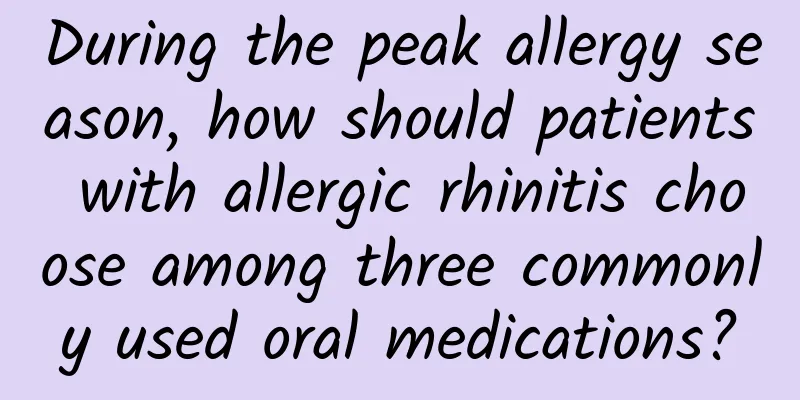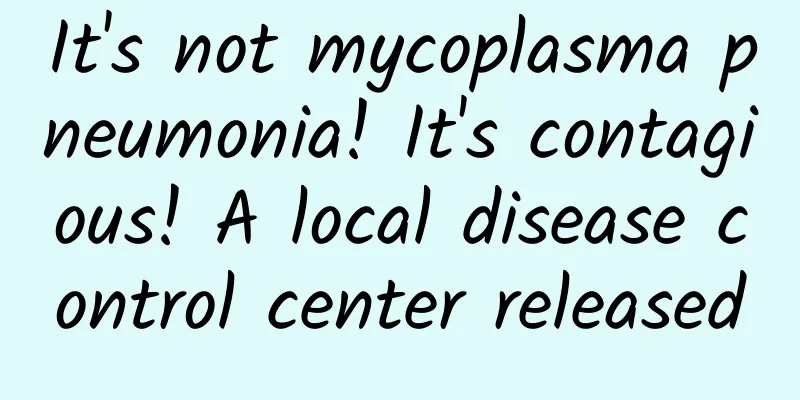During the peak allergy season, how should patients with allergic rhinitis choose among three commonly used oral medications?

|
March is a good time for everything to come back to life. However, the fluff, pollen, and rising ultraviolet light intensity make allergic rhinitis patients miserable. Therefore, loratadine, which is called a "life-saving drug" by allergic people, has been mentioned frequently and even topped the hot search list recently! Some reports say that some types of loratadine have been sold out. Statistics show that the number of patients with allergic rhinitis in my country is as high as 240 million, and the prevalence rate is close to the level of developed countries (20%). Therefore, the demand for antiallergic drugs is very large. In addition to loratadine, commonly used oral antiallergic drugs also include chlorpheniramine maleate and cetirizine, which are also effective for allergic rhinitis. So how should these three commonly used oral antiallergic drugs be selected? What are the differences? Clinicians should fully understand. 1. First-generation antihistamines: Chlorpheniramine maleate Chlorpheniramine maleate, which we call chlorpheniramine, is a histamine H1 receptor antagonist and a first-generation antihistamine drug. This product is suitable for skin allergy symptoms, including urticaria, eczema, dermatitis, drug rash, pruritus, neurodermatitis, insect bites, solar dermatitis, etc. It can also be used for allergic rhinitis or drug and food allergies. It can effectively relieve nasal congestion caused by allergic rhinitis and upper respiratory tract infections, as well as urticaria, hay fever, vasomotor rhinitis, etc. It can also relieve skin itching and edema caused by insect bites, drug rash and contact dermatitis. However, the sensitizing drugs must be discontinued or contact must be avoided during the medication period. The oral onset time is 15 to 60 minutes, the half-life is 12 to 15 hours, and the efficacy can be maintained in the body for 4 to 6 hours. Dosage form or specification: Chlorpheniramine maleate tablets: 1 mg, 4 mg . Ampheniramine maleate drops: 2 mg, 4 mg . Dosage and Administration: Tablets : Oral administration. Adults: 4 mg/time, 3 times/day. · Pills: Oral administration, 1 pill per time, 3 times per day for adults. It can be taken with food, water or milk to reduce stomach irritation. Contraindications: · People who are allergic to this product are prohibited from using it. It is contraindicated in patients with epilepsy or receiving monoamine oxidase inhibitors. People who should use with caution: Pregnant and lactating women. Patients with bladder neck obstruction and pyloric duodenal obstruction. Patients with hyperthyroidism. Patients with glaucoma. Patients with peptic ulcer. People with high blood pressure and prostate enlargement. Interactions with other drugs: This product should not be taken together with compound cold medicines containing antihistamines (chlorpheniramine maleate, diphenhydramine, etc.). This product should not be taken with medicines containing anticholinergic drugs (such as belladonna preparations, atropine, etc.). When used in combination with antipyretic and analgesic drugs, it can enhance its analgesic and cold symptom relief effects. Concomitant use with central nervous system depressants , hypnotics, tranquilizers or ethanol may increase the inhibitory effect on the central nervous system. · This product can enhance the effects of antidepressants and should not be used together. Note: Chlorpheniramine maleate is a first-generation antihistamine drug that easily penetrates the blood-brain barrier, causing drowsiness, fatigue, sleepiness, etc. It may also cause dry mouth, nausea, palpitations, etc. During medication, you are not allowed to drive a plane, car, or boat, or engage in high-altitude work, mechanical work, or operate precision instruments. 2. Second-generation antihistamines: cetirizine and loratadine Second-generation antihistamines are the first-line treatment for allergic rhinitis and are often recommended for clinical use. They have a rapid onset of action and a long duration of action, and can significantly relieve nasal symptoms, especially nasal itching, sneezing, and runny nose. They are also effective for combined eye symptoms, but their effect on improving nasal congestion is limited. Loratadine and cetirizine are both second-generation H1 receptor antagonists, but because of their different drug ingredients, they are also different in their use. Loratadine Loratadine is mainly used to relieve symptoms related to allergic rhinitis, such as sneezing, runny nose, nasal itching, nasal congestion, itchy eyes, burning sensation, as well as chronic urticaria, itchy skin diseases and other skin symptoms and signs caused by allergies. It can also be used as an adjuvant medication for allergic asthma and for anti-allergic treatment of jellyfish stings, bee stings, etc. The oral onset time is generally 1 to 3 hours, the drug half-life is about 12 hours, and the in vivo efficacy is generally maintained for more than 24 hours. Dosage form or specification: Tablets : 10 mg/tablet. Capsules: 5 mg, 10 mg. Granules: 5 mg, 10 mg. Syrup : 0.1% (60 ml: 60 mg). Dispersible tablets : 5 mg, 10 mg. Effervescent tablet : 10 mg/tablet. Dosage and Administration: Tablets /capsules/granules: Adults and people over 12 years old, oral, 10 mg/time, once/day. Patients with liver and kidney dysfunction should reduce the dosage, it is recommended to take 10 mg/time, once every 2 days or use under the guidance of a doctor. For children aged 2 to 12 years and weighing more than 30 kg, take 10 mg once a day. For children weighing ≤30 kg, take 5 mg once a day. Syrup : Adults and children over 12 years old, 2 teaspoons (10 ml) at a time, once a day. For children aged 2 to 12 years, weighing more than 30 kg, take 2 teaspoons (10 ml) at a time, once a day; for children weighing ≤30 kg, take 5 mg once a day. Contraindications: Patients with known allergy to loratadine or other ingredients in this product are contraindicated. People who should use with caution: Pregnant and lactating women. Those with a history of arrhythmia. Patients with renal insufficiency. Patients with severe liver dysfunction should use this product under the guidance of a doctor. Interactions with other drugs: Taking ketoconazole , cimetidine, theophylline and other drugs at the same time will increase the concentration of loratadine in plasma and should be used with caution. Loratadine is metabolized by the liver CYP450 enzyme. Therefore, drugs that inhibit the activity of liver enzymes, such as macrolide antibiotics, can slow down the metabolism of this drug, increase the blood concentration of this drug, and may lead to increased adverse reactions. · Combination with other central nervous system depressants (such as barbiturates, phenylenediamine sedatives, phenothiazine sedatives) and tricyclic antidepressants may cause severe drowsiness. Monoamine oxidase inhibitors may increase the adverse reactions of this product. Note: Adults who take an overdose of this product (40-180 mg) may experience drowsiness, arrhythmia, headache and other symptoms. Once the above symptoms occur, symptomatic and supportive treatment should be given immediately. Common adverse reactions include fatigue, headache, drowsiness, dry mouth, gastrointestinal discomfort (including nausea, gastritis) and rash, and occasionally amnesia and facial and acral edema in the morning. Cetirizine Cetirizine is mainly used to treat allergic diseases, such as seasonal rhinitis, perennial allergic rhinitis, allergic conjunctivitis, and symptomatic treatment of itching and urticaria caused by allergies. It can relieve symptoms such as nasal congestion, runny nose, sneezing caused by seasonal or allergic rhinitis, eye symptoms such as itchy eyes caused by allergic conjunctivitis, and type I hypersensitivity symptoms such as skin redness, swelling, and itching in patients with allergic rashes and urticaria. Cetirizine is rapidly absorbed from the gastrointestinal tract after oral administration, with peak plasma concentrations occurring within approximately 1 hour and a half-life of approximately 10 hours. Dosage form or specification: Tablet : 10 mg. Capsules : 5 mg, 10 mg. Drops : 10 mg/ml. Oral solution: 1 mg/ml. Syrup : 1 mg/ml. Dosage and Administration: Tablets /capsules/drops: Adults and children 6 years and older: Oral, 10 mg per day as a single dose, or divided into 2 doses (morning and evening). For children aged 2 to 6 years, take orally 5 mg per day as a single dose or divided into 2 doses. Children 1 to 2 years old: oral, 2.5 mg, once a day. This product is not recommended for children 1 year old and younger. Oral solution/syrup: Adults and children aged 12 years and above, oral administration, 10 ml/time, once a day. If adverse reactions occur, it can be changed to once in the morning and evening, 5 ml each time. For children aged 6 to 11 years, the recommended starting dose is 5 ml, once a day, taken orally, depending on the severity of symptoms. For children aged 2 to 5 years, the recommended starting dose is 2.5 ml, once a day, for oral administration. Contraindications: · Contraindicated for patients allergic to this product or hydroxyzine. Contraindicated in patients with severe renal impairment. People who should use with caution: Patients with impaired liver function should use this product with caution. Patients with epilepsy or those at risk of seizures. Patients with urinary retention susceptibility factors (such as spinal cord damage, prostatic hypertrophy, etc.) should use this drug with caution, as it may increase the risk of urinary retention. Women in the first 3 months of pregnancy and breastfeeding. Patients who drink alcohol should use this product with caution. Interactions with other drugs: Caution should be exercised when taking with sedatives (hypnotics) or theophylline. Note: This drug is absorbed rapidly after oral administration and may cause drowsiness after taking it. Therefore, you should not drive a plane, car or boat, engage in high-altitude work, mechanical work or operate precision instruments while taking the drug. A single oral dose of 50 mg may cause drowsiness, but there is no specific antidote so far. In the case of a serious overdose, gastrointestinal lavage should be performed promptly. In addition to general emergency supportive treatment, all vital signs of the patient must be monitored regularly. During the use of the drug, if severe liver and kidney damage or severe arrhythmia (QT interval prolongation or torsades de pointes) occurs, the drug must be discontinued immediately. References [1] Chinese Pharmacopoeia Committee, Pharmacopoeia of the People's Republic of China (2020 Edition) [M]. Beijing: China Medical Science and Technology Press, 2020, 5: 1120-1122. [2] Rhinology Group of the Editorial Committee of the Chinese Journal of Otorhinolaryngology Head and Neck Surgery, Rhinology Group of the Chinese Society of Otorhinolaryngology Head and Neck Surgery. Chinese Guidelines for the Diagnosis and Treatment of Allergic Rhinitis (2022, Revised Edition) [J]. Chinese Journal of Otorhinolaryngology Head and Neck Surgery, 2022, 57(2): 106-129. |
<<: Do not abuse painkillers during gout attacks and do not neglect long-term treatment
>>: What are the symptoms of gout and what kind of pain is it?
Recommend
How many weeks is 5 months pregnant
5 months of pregnancy should be 21 weeks. This st...
What are the symptoms of thyroid nodules in women?
Recently, some female friends have raised questio...
What causes vaginal itching? Causes of vaginal itching
When women experience vaginal itching, they shoul...
Can I eat longli fish during menstruation?
Women during menstruation need to supplement prot...
What is the role of skipping rope after ectopic pregnancy?
Everyone knows the great harm of ectopic pregnanc...
Typical symptoms of menopause in women
Once women reach the age of 45, they are likely t...
What are the main factors for selecting automotive lubricants? What does the fluidity of lubricants represent?
The lubricating oil of the car is the lubricating...
Why does the vagina always have an odor?
There is always an odor in the vagina, which many...
How much hcg can be used to see the gestational sac
During the period of women's pregnancy prepar...
What fruits are better to eat during menstruation?
Many female friends like to eat fruits because th...
Menstrual cycle calculator for girls
The menstrual cycle calculation method is a syste...
Why do stretch marks become itchy after childbirth?
It is normal for female friends to have stretch m...
What is female genital itching?
Women are often embarrassed when they have proble...
Chronic pelvic inflammatory disease cannot be cured
Many female friends have found in the process of ...
How to make turtle hotpot? What to eat after hotpot to reduce fat?
Modern people love to eat hot pot. Because during...









